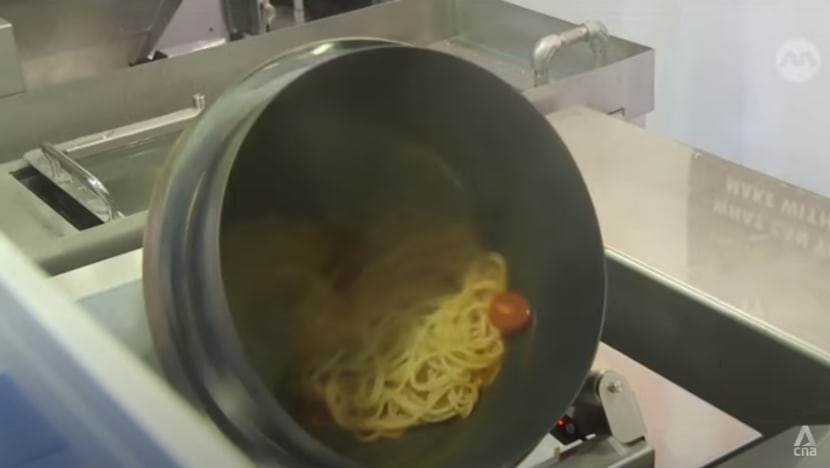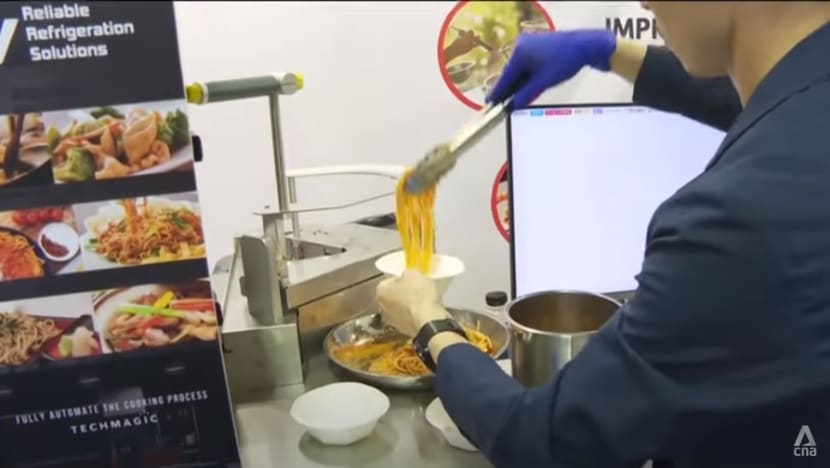Robot chefs and waiters: 40% of food services jobs will require moderate to extensive redesign in next 3 years
Firms looking to redesign jobs can get up to 70 per cent funding support, while an up to 90 per cent wage subsidy scheme is in place for employers reskilling workers for new roles.

A robot waiter serves customers at a restaurant.
SINGAPORE: Four in 10 jobs in the food services sector here will require moderate to extensive redesign in the next three years, according to a manpower roadmap.
As technological and digital transformation accelerate to meet rising demand for convenience and efficiency, multiple roles in the industry will have to be redesigned to keep pace with these changes.
From frontline staff, such as waiters to back-end crew like kitchen cooks, employees will have to be retrained in order to keep one of Singapore’s key economic drivers humming.
THE ROBOTS ARE COMING
One key driver of job transformation in the industry is the increasing popularity of robotics in the kitchen.
A Japanese machine distributed by culinary equipment distributor TY Innovations, for instance, can cook a plate of bolognese pasta in just 45 seconds.
It can churn out 90 plates of pasta every hour – about 10 times faster than the average restaurant.
No human intervention is needed until the last step of plating the food.
With this robot, a restaurant could operate without station cooks or kitchen assistants, and just one person will be able to do the work of four.

The firm said the technology standardises the cooking process, increases consistency in taste, and optimises workflow and efficiency.
“What we are trying to achieve is to ease up the cooking process,” said Mr Frank Quek, CEO of TY Innovations.
“I believe more time and energy can go into upskilling workers into handling other areas, bringing more to customer service or maybe HR (Human Resources) management or inventory planning.”
The machine is set to make its way into restaurants in a few months.
FUTURE OF F&B STAFF
Robots are also taking over the roles of some service personnel.
Robot waiters are becoming a common sight, increasingly seen in eateries including popular hotpot restaurant Haidilao and dimsum hotspot Swee Choon.

Additionally, self-ordering kiosks have popped up across fast food chains and bubble tea outlets in recent years.
With the influx of these machines, the future of eateries could see minimal kitchen and floor staff. Current employees will have to be reskilled in areas like customer satisfaction and service improvement.
Industry players said the jobs transformation is already taking place, and both employers and employees in the food and beverage (F&B) sector must embrace the changes or be left behind.
“The most challenging part is the mindset. There must be a willingness to adapt,” said Mr Andrew Kwan, president of the Restaurant Association of Singapore.
“There must be an agility of the mind to say, ‘let's recognise the trends and make adjustments accordingly’.”
JOBS TRANSFORMATION MAP
To help the sector, a Jobs Transformation Map was launched last week, laying out plans for workers to upskill themselves and take on new roles, such as sustainability specialists or restaurant designers.
“For the workers, it is more critical now than ever to adapt to the speed of changes, and to keep on improving their skills and knowledge,” said Minister of State for Trade and Industry Low Yen Ling.
“Workers who take charge of their own career and professional development by constantly acquiring new skills are the ones who will stay relevant and highly employable.”
Firms looking to redesign jobs can get up to 70 per cent funding support.
An up to 90 per cent wage subsidy scheme is also in place for employers who are reskilling existing workers for new roles.
Ms Low said there is growing consumer demand for convenience, personalised and experiential services, and sustainable practices.
Another key trend shift she highlighted is a greater adoption of technology for digital solutions and automation equipment since the COVID-19 pandemic.
An ageing local workforce and changing career aspirations of Singapore’s youth have also led to more competition for workers.
These challenges mean that companies need to redesign jobs, embrace technology, and optimise their manpower model to stay competitive, Ms Low said.
Last year, the food services industry employed about 235,000 workers and contributed some S$4.5 billion to Singapore’s economy.


















